< Previous | Contents | Next >
ESTABLISHED 1820.
BARRINGER AND COMPANY, LIMITED,
Manufacturers of Mustard, Blue and Blacklead; Pepper Merchants, and Marrowfat Pea Factors, Rock Valley Mills, MANSFIELD.
Telephone No. 1932.
10 Station Chambers, Neville Street, NEWCASTLE-ON-TYNE.
8 Drury Street, GLASGOW.
Pea Warehouses—Paddock Granaries, BOSTON.
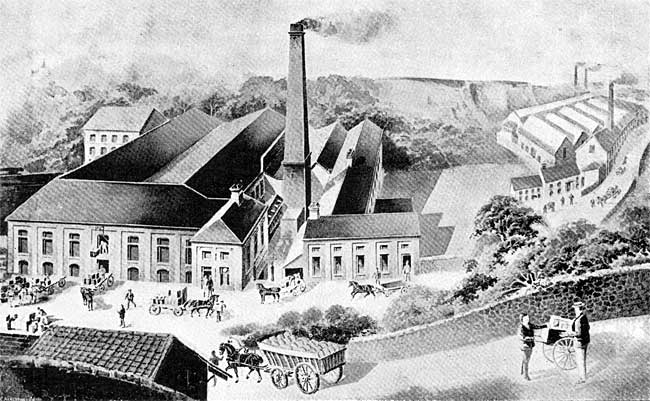
General View of Works.
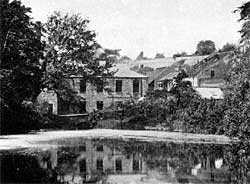
View of Works from the East.
ROCK Valley Mills is the appropriate name of the works where Barringer and Company, Limited, manufacture their mustard, blue, and black lead. These works which are pleasantly situated on the river Maun were established when our gracious Queen was only one year old, when Mr. Gladstone was a boy of eleven, and ten years before Lord Salisbury was born. This was in the year 1820, at which time the river was the sole source of power.
In 1820 Sherwood Forest came right up to the outskirts of Mansfield, and to drive from Mansfield to Nottingham was to pass through continuous forest land. Even now the magnificent remnant known as the Dukeries is not many miles away, and every summer hundreds of visitors are delighted and amazed at the great oaks and silver birches and the long stretches of sylvan scenery that are to be found at Clumber, Welbeck, Thoresby, and Rufford.
There you are still reminded of Robin Hood, Little John, and Friar Tuck, and realise the words of the old ballad—
"What life is there like to bold Robin Hood? It is so pleasant a thing. In merry Sherwood to spend his days, As pleasantly as a king."
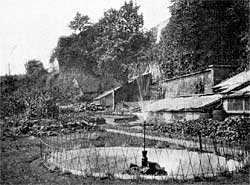
View in the Grounds of Rock Valley Mills.
Since 1820, when the business was founded, the Mills have greatly developed, but part of the old building has survived the scourges of fire, time, and tempest, and there is a window still preserved upon which is scratched: — "Burnt down in the 9 mo. 1812. Rebuilt in the 3 mo. 1813," the man who wrote this (85 years ago) having made several capital B's before he got one to his liking. This part of the works is shown here in a reproduction of the photograph, "On the way to the Old Mill," and the window-alluded to is the furthest to the right on the upper row.
The river flows under the Mills, and on its eastern side widens to a picturesque dam as shown in the illustration, and then continues on its way to be purified by the Duke of Portland's flood dykes, and to become a well-stocked trout stream as it flows by Clipstone Wood, which is one of the finest pheasant preserves in England.
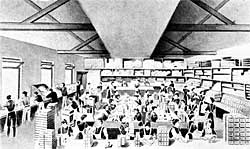 Mustard Packing Room.
Mustard Packing Room.Such is the situation of Barringer's Mustard Mills, and hither from the fertile fields of the Eastern Counties are brought train loads of seed, here to be converted into Barringer's Mustard.
It will be in the remembrance of the reader how "Taffy," the "Laird," and "Little Billee," in Trilby, loved the English eating-house in Paris, where they could get "bracing, biting, stinging yellow mustard."
This is the kind that Messrs. Barringer and Co. claim to make and pack, and they point out that no industry is more essentially British. Their mustard is "grown in Britain, made in Britain, and eaten by Britons."
It has been said that most of the seed comes from the Eastern Counties.
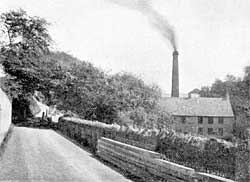
On the road to the Old Mill.
The land where it grows is a magnificent monument to the industry and capability of man. Mr. Stevenson, in his work on the "Birds of Norfolk," says, "It may be doubted if at the present time any part of this district can be truly said to preserve its natural aspect. The spectator must draw upon his imagination to picture to his eye the whole of the level plain as it appeared even a hundred years ago, when, in place of the luxuriant crops of oats, mangold-wurtzel, mustard, and Swedish turnips, it was one uniform bed of sedge, varied only by a few lone sallow bushes."
The character of the country has indeed altered, and the Fenman, who was supposed to be born "with a speckled belly and a web between his toes," has ceased to exist, and has become a grower of mustard and marrowfat peas.
The mustard harvest generally commences about the first week in August. There are two sorts known in the trade as brown and white, though the word "yellow" would better describe the latter.
Thousands of sacks of both sorts may be seen in Messrs. Barringer's warehouses. The "brown" is the smaller, but is the most expensive, because an acre of land will not yield so much of it as it will of the "white," and it also exhausts the soil more. It has, however, properties not possessed by the "white," and both sorts are absolutely essential in the making of good mustard.
Messrs. Barringer and Company possess very perfect machinery for husking, grinding, and dressing the mustard, and no pains or expense are spared in order to obtain the finest result. The firm has the accumulated experience of seventy years, but the principals believe it is always possible to learn, and so improvements continue to be made. Quite recently an elaborate machine of a new type has been put up with most satisfactory results.
After the mustard has completed its manufacturing journey it requires to be packed.
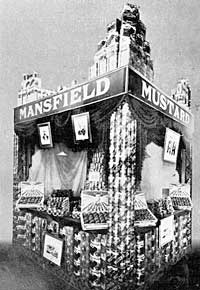
Exhibition Show Stand.
Messrs. Barringer and Co. have always been to the front with their packages, and always have on hand a large variety of handsome tins of various sizes and shapes.
Considerable thought is necessary to choose suitable designs. Messrs. Barringer and Co. have drawn their ideas from many fields. They have frequently had tins bearing representations of flowers—one of the most successful having been of "Chrysanthemums," which were sketched from Mr. Barringer's own collection. They have also had resort to Shakespeare and Scott, to English history, politics, bird life and child life, and to Barnum and football; they have drawn on the Arctic regions, the Tropics, the cities of Europe, the Colonies, and with not least success on the beautiful country in their own neighbourhood.
They have lately introduced a speciality known as "Motor" Mustard, which is packed in blue and yellow lever-lid tins, and which they claim is the most convenient package on the market.
The excellence of the firm's manufactures is evidenced by the large number of prize medals they have obtained at exhibitions in all parts of the world.
We have left ourselves no space to allude to the Blue and Black Lead departments.
They are manufactured and packed in a separate building from the Mustard. Quite a number of girls are employed in this branch, as the Blue has to be wrapped either in paper or calico and then packed into boxes.
Messrs. Barringer and Co. are the manufacturers of Portland Blue, which is packed in ornamental tins, and they also send large quantities of Washing Blue and Black Lead to Australia and the Continent of Europe.
